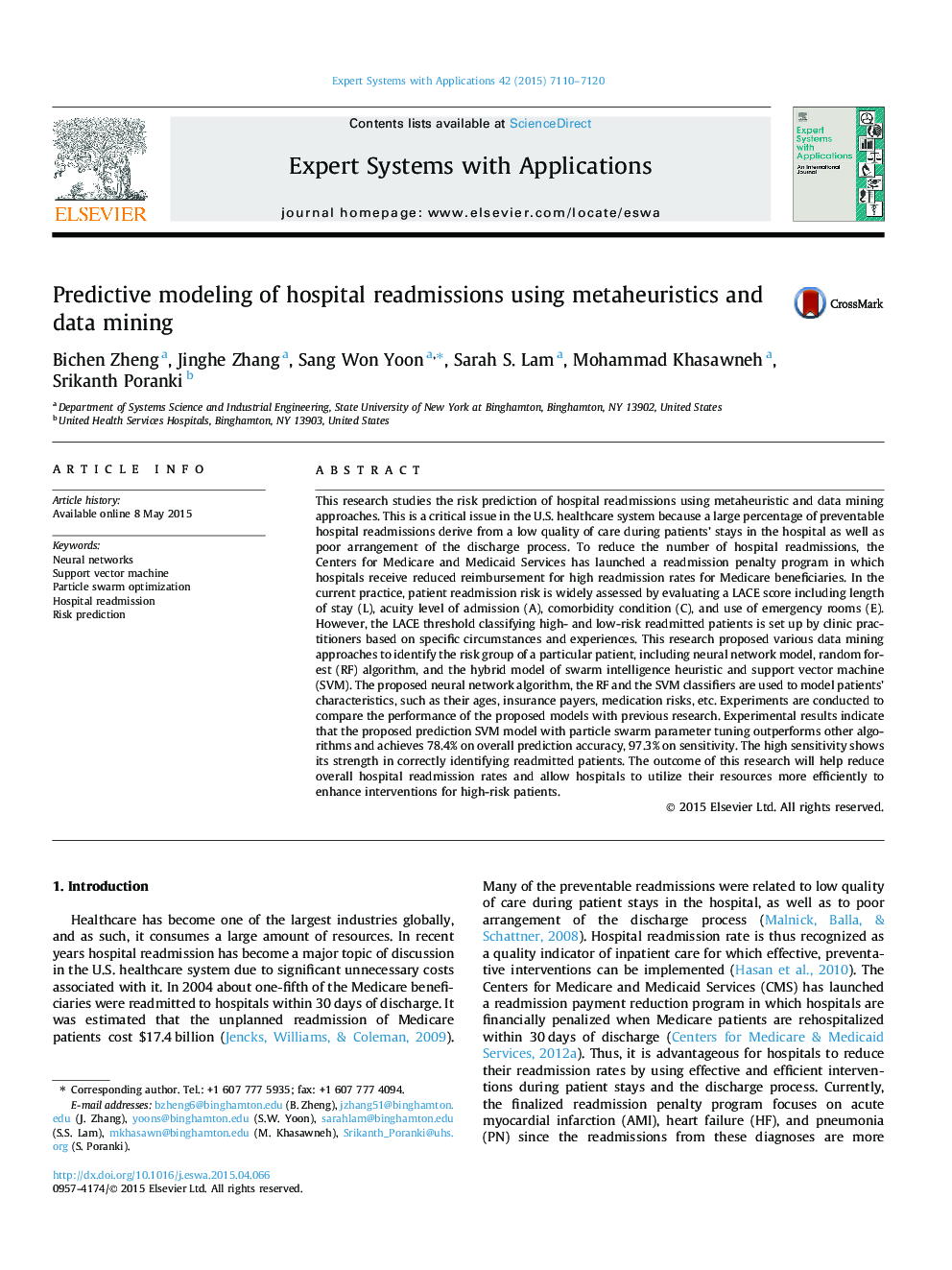| کد مقاله | کد نشریه | سال انتشار | مقاله انگلیسی | نسخه تمام متن |
|---|---|---|---|---|
| 382077 | 660728 | 2015 | 11 صفحه PDF | دانلود رایگان |
کلیدواژه ها
1. مقدمه
2. بررسی مطالعات
جدول 1. نقشه پژوهشی برای تطابق بین نواحی و رویکردهای پژوهشی در زمینه پیش بینی پذیرش مجدد بیمار
3. روش پیشنهادی
3.1. شرح داده
3.2. پیش پردازش داده
جدول 2. دید کلی ویژگی های ورودی
3.3. شبکه های عصبی تابع پایه شعاعی
شکل 1. آمارهای توصیفی از داده خام حاصل از رکوردهای پزشکی
3.4. جنگل تصادفی
3.5. SVM مبتنی بر بهینه سازی گروهی ذرات
شکل 2. ابرسطح های SVM در طبقه بندهای دودویی
شکل 3. تابع کرنل برای طبقه بندی قابل تفکیک غیرخطی
جدول 3 سه نوع توابع کرنل
جدول 4 الگوریتم PSO-SVM
4. نتایج آزمایشی و تحلیل
4.1. معیارهای بهره وری
4.2. آموزش تحلیل نتایج
جدول 5 بهره وری آموزش روش های پیشنهادی
شکل 4. نمونه ای از درخت طبقه بندی در مدل جنگل تصادفی
4.2.1. شبکه های عصبی تابع پایه شعاعی
4.2.2. آموزش مدل جنگل تصادفی
4.2.3. آموزش PSO-SVM
شکل 5. مقایسه دقت بر تعداد ویژگی ها در سطح گره جنگل تصادفی
جدول 6 نتایج آزمایشی طبقه بندهای SVM با توابع کرنل مختلف
شکل 7. مقایسه دقت پیش بینی روش های پیشنهادی
شکل 6. مقایسه دقت پیش بینی پذیرش مجدد بیمار
شکل 7. دقت تست پیش بینی بر اساس 10 5-fold cross-validations.
4.3. مقایسه های نتیجه تست آزمایشی روش پیشنهادی
5. نتیجه گیری و کارهای آینده
• Risk predictions of hospital readmission for heart failure patients are investigated.
• RBFNN, RF and PSO–SVM models are used to predict patient readmission risk.
• The PSO–SVM achieves 78.4% on overall accuracy and 97.3% on sensitivity.
• The PSO–SVM outperforms over traditional prediction models, including LACE scores.
This research studies the risk prediction of hospital readmissions using metaheuristic and data mining approaches. This is a critical issue in the U.S. healthcare system because a large percentage of preventable hospital readmissions derive from a low quality of care during patients’ stays in the hospital as well as poor arrangement of the discharge process. To reduce the number of hospital readmissions, the Centers for Medicare and Medicaid Services has launched a readmission penalty program in which hospitals receive reduced reimbursement for high readmission rates for Medicare beneficiaries. In the current practice, patient readmission risk is widely assessed by evaluating a LACE score including length of stay (L), acuity level of admission (A), comorbidity condition (C), and use of emergency rooms (E). However, the LACE threshold classifying high- and low-risk readmitted patients is set up by clinic practitioners based on specific circumstances and experiences. This research proposed various data mining approaches to identify the risk group of a particular patient, including neural network model, random forest (RF) algorithm, and the hybrid model of swarm intelligence heuristic and support vector machine (SVM). The proposed neural network algorithm, the RF and the SVM classifiers are used to model patients’ characteristics, such as their ages, insurance payers, medication risks, etc. Experiments are conducted to compare the performance of the proposed models with previous research. Experimental results indicate that the proposed prediction SVM model with particle swarm parameter tuning outperforms other algorithms and achieves 78.4% on overall prediction accuracy, 97.3% on sensitivity. The high sensitivity shows its strength in correctly identifying readmitted patients. The outcome of this research will help reduce overall hospital readmission rates and allow hospitals to utilize their resources more efficiently to enhance interventions for high-risk patients.
Journal: Expert Systems with Applications - Volume 42, Issue 20, 15 November 2015, Pages 7110–7120
